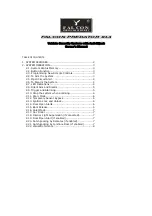
Technical Bulletin
SuperDuct Signature Duct Smoke Detector
1
SuperDuct Signature Duct Smoke
Detector
P/N 3100738 • Rev 02 • 18JAN17
Content
Introduction ............................................................................ 1
Related documents .................................................................. 1
Duct smoke detector limitations ............................................... 1
Product description ............................................................... 1
Overview .................................................................................. 1
Description ............................................................................... 2
Features ................................................................................... 2
Specifications ........................................................................... 3
Accessories .............................................................................. 3
Operation ................................................................................ 4
Controls and indicators ............................................................. 4
Normal state ............................................................................. 4
Alarm state ............................................................................... 4
Trouble state ............................................................................ 4
Installation .............................................................................. 4
Installation guidelines ............................................................... 4
Installation sequence................................................................ 5
Installing the sampling tube from the front of the detector ........ 5
Supporting sampling tubes greater than 36 inches long .......... 5
Wiring ....................................................................................... 6
Configuration ............................................................................ 6
Maintenance and service ....................................................... 6
Recommended service schedule ............................................. 6
Testing the duct smoke detector .............................................. 6
Troubleshooting ....................................................................... 6
Cleaning the duct smoke detector ............................................ 6
Introduction
This document provides technical information for the
SuperDuct Signature Duct Smoke Detector (referred to simply
as duct smoke detector for the remainder of this document.)
This document applies to the following duct smoke detector
model: SIGA-SD.
Related documents
In addition to this document, important information regarding
the proper installation and maintenance of duct smoke
detectors is provided in the following standards:
• NFPA
70
National Electrical Code
• NFPA
72
National Fire Alarm Code
• NFPA
90A
Installation of Air Conditioning and
Ventilating Systems
• UL
268A
Smoke Detectors for Duct Applications
• ULC
529
Smoke Detectors for Fire Alarm Systems
• NEMA
Guide for Proper Use of Smoke Detectors in Duct
Applications
Duct smoke detector limitations
SuperDuct duct smoke detectors will not operate without
electrical power.
SuperDuct duct smoke detectors will not operate as designed
outside of the listed electrical and environmental
specifications.
SuperDuct duct smoke detectors will not sense smoke unless
the ventilation system is operating and the sensor’s cover is
properly installed.
SuperDuct duct smoke detectors may not operate as designed
unless installed in accordance with these instructions and all
applicable national and local codes as determined by the local
authority having jurisdiction.
Product description
Overview
The duct smoke detector is used to detect smoke under
extended temperature ranges, typically in self-contained
commercial rooftop HVAC systems. In self-contained
commercial HVAC units, the HVAC equipment is enclosed in
a single package to protect the internal components
(compressor, condensing unit, heating coils, etc.) from adverse
environmental conditions. Hinged or removable service panels
provide access to the equipment.



























